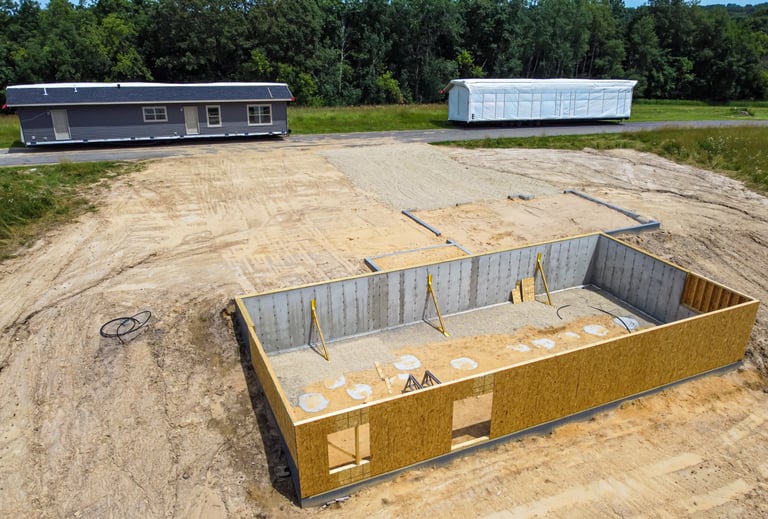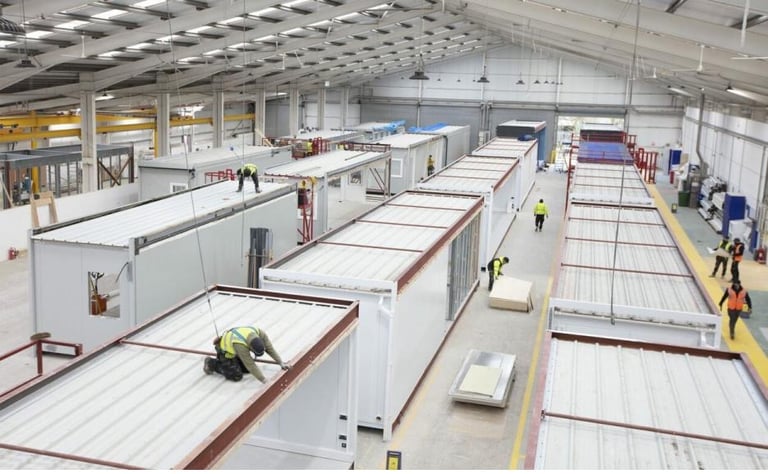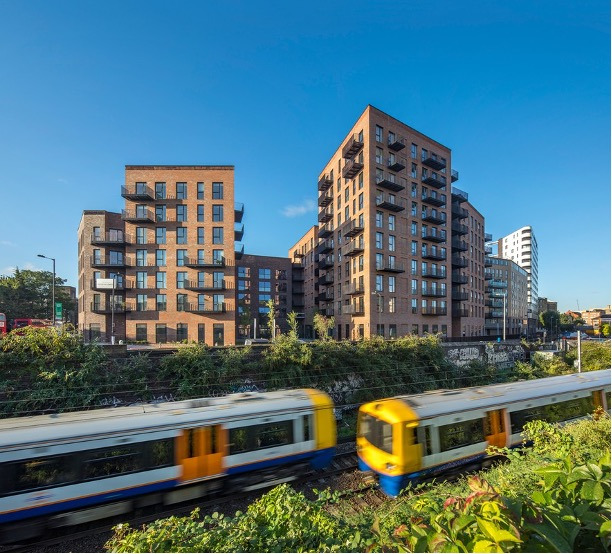Why Modular Construction is key to a sustainable and efficient future
The construction sector is experiencing a significant transformation. As climate change, limited resources, and increasing urban populations put increasing pressure on the industry, innovative building techniques are being developed to tackle both efficiency and sustainability issues. Among the most promising methods are prefabrication and modular construction. By producing building components offsite and assembling them on-site, these techniques reduce waste, lower costs, and speed up project timelines. More crucially, they align with global objectives for sustainable development, low-carbon construction, and the circular economy.
MOST RECENTCONSTRUCTION AND ENERGY
Neel Joshi
10/5/20255 min read


WHAT IS PREFABRICATION AND MODULAR CONSTRUCTION?
Prefabrication refers to the process of manufacturing individual building components, such as walls, floors, and roof panels, in a controlled factory environment before transporting them to the construction site.
Modular construction is prefabrication taken a step further, producing entire modules (like apartments, classrooms, or hotel rooms) that are then stacked and connected on-site.
These methods contrast with traditional construction, where most activities occur directly on-site, often resulting in longer timelines, higher costs, and greater environmental impact.
SUSTAINABILITY BENEFITS OF PREFABRICATION AND MODULAR CONSTRUCTION
Decreased material waste: Factory-controlled settings facilitate accurate cutting, standardized procedures, and the recycling of surplus materials. This results in a reduction of waste by up to 90% when compared to traditional construction methods.
Reduced carbon footprint: A decrease in site deliveries and shorter construction durations leads to lower transport emissions. Energy-efficient designs and the incorporation of low-carbon materials during off-site manufacturing further reduce embodied carbon.
Enhanced energy performance: Prefabricated units can be engineered with airtight seals, superior insulation, and advanced glazing systems, yielding buildings with improved energy efficiency ratings
Minimized on-site disruption: Traditional construction frequently generates dust, noise, and traffic congestion in nearby communities. Offsite production minimizes these disturbances and enhances community well-being.
Circular Economy Compatibility: Modular structures can be designed for disassembly, enabling components to be reused, reconfigured, or recycled at the conclusion of their lifecycle.
EFFICIENCY
Faster project delivery: Prefabrication allows site preparation and fabrication of modules simultaneously. As a result, projects can be completed 30–50% faster than conventional techniques.
Cost savings: Regulated factory settings minimize labor expenses, material waste, and delays caused by weather, resulting in predictable budgets and overall cost reductions.
Enhanced Quality Assurance: Factory environments guarantee consistent production, reducing human errors and resulting in components with increased durability.
A solution for labour shortage: In light of global labour shortages in the construction sector, prefabrication reallocates much of the workforce demand from on-site trades to manufacturing roles within factories.
PREFABRICATION & MODULAR CONSTRUCTION IN THE CIRCULAR ECONOMY
One of the most significant synergies between modular construction and the circular economy is the capacity to design for disassembly, reuse, and reconfiguration, converting what would typically be construction waste into continuous material value.
Disassemblable joints & connections: Modular units can be assembled using reversible fasteners, facilitating straightforward disassembly and reuse.
Standardized components: Factories are capable of producing building blocks (frames, panels, MEP modules) that can be utilized across various projects.


Image courtesy: Premier Modular
Component leasing models: Manufacturers can maintain ownership of high-value modules (e.g. façade panels, HVAC blocks) and lease them for reuse.
Circular material selection: The use of recycled steel, renewable composites, and biobased materials enhances the sustainability of modular construction.
Adaptive reuse: Modular buildings can be reconfigured to accommodate evolving needs such as transforming hotel units into residential apartments.
PROJECTS ACROSS THE WORLD
Dalston Works (London, UK)
Finished in 2017, Dalston Works is a ten-story residential structure built entirely from cross-laminated timber (CLT), positioning it among the largest timber modular buildings globally. Prefabricated offsite and assembled on location, it significantly minimized construction waste and embodied carbon—sequestering approximately 2,600 tonnes of CO₂. This project exemplifies how modular timber design can achieve both rapid construction and sustainability while promoting circular building practices.


Image Courtesy - Waugh Thistleton Architects
Clement Canopy (Singapore)
Finished in 2019, this twin-tower project comprises two 40-story high-rise residential towers, which were the tallest modular buildings globally at that time. It utilized Prefabricated Prefinished Volumetric Construction (PPVC), with nearly 1,900 modules manufactured offsite and assembled on location. The construction duration was shortened by approximately 25% in comparison to traditional methods. This approach enhanced quality control and minimized the need for labor on-site. Additionally, it led to a decrease in dust, noise, and disturbances to nearby communities.
Apex House (London, UK)
Completed in 2017, Apex House in Wembley was Europe’s tallest modular building at the time, standing 29 stories high and housing over 550 student rooms. Built from 679 prefabricated modules assembled in just 13 weeks, the project achieved a BREEAM Excellent rating and reduced CO₂ emissions by over 30% compared to standard construction. Its precision off-site fabrication minimized waste, shortened project timelines, and demonstrated how modular construction can deliver high-rise, sustainable urban housing efficiently.
CHALLENGES TO OVERCOME
High initial investment: Factories and technology require significant upfront capital. Modular construction involves a slightly longer initial planning and designing phase.
Perception issues: Some still associate modular buildings with lower quality, despite evidence to the contrary.
Transport logistics: Moving large modules to urban areas can be challenging.
Regulatory hurdles: Building codes and standards in many regions are still tailored to traditional construction methods.
THE ROAD AHEAD
As governments, developers, and architects emphasize sustainability, prefabrication and modular construction are set to become integral to the future of construction. Innovations in robotics, 3D printing, and digital design - such as Building Information Modeling and digital twins will significantly improve efficiency and promote circularity. To scale these approaches, it is essential to establish supportive policy and regulatory frameworks, increase investment in modular manufacturing facilities, and educate the public to shift perceptions toward high-quality modular design.
CONCLUSION
Prefabrication and modular construction represent more than just a technological innovation. They are a roadmap toward a more sustainable and circular built environment. By reducing waste, cutting emissions, and enabling reuse and adaptability, these methods address some of the most pressing challenges facing the construction industry today. With continued adoption and innovation, prefabrication and modular construction will help shape efficient cities that are resilient and environmentally responsible.
REFERENCES
Bertram, N., Fuchs, S., Mischke, J., Palter, R., Strube, G. and Woetzel, J. (2019). Modular construction: From projects to products. [online] Available at: https://www.mckinsey.com/~/media/mckinsey/business%20functions/operations/our%20insights/modular%20construction%20from%20projects%20to%20products%20new/modular-construction-from-projects-to-products-full-report-new.pdf.
Dixon, L. (2025). Why Rapid Deployment Modular Buildings are Reshaping Construction. Premier Modular. Available at: https://www.premiermodular.co.uk/rapid-deployment-modular-buildings/
Ellen MacArthur Foundation (2024). Building Prosperity - Unlocking the potential of a nature-positive, circular economy for Europe. Available at: https://content.ellenmacarthurfoundation.org/m/62e7613596a2d12f/original/Building-Prosperity-July-2024.pdf.
Ellen MacArthur Foundation (2022). Reimagining our buildings and spaces for a circular economy. Available at: https://www.ellenmacarthurfoundation.org/topics/built-environment/overview.
Jones, V. (2021). Dalston lane - the largest cross laminated timber residential structure in europe - Structural Timber Association. Structural Timber Association. Available at: https://www.structuraltimber.co.uk/news/dalston-lane-the-largest-cross-laminated-timber-residential-structure-in-europe/.
Parisi, L., Donyavi, S. Modular momentum: assessing the efficacy of modular construction in alleviating the UK housing crisis. Discov Appl Sci 6, 548 (2024). https://doi.org/10.1007/s42452-024-06268-4
Waugh Thistleton Architects (2017). Dalston Works | Waugh Thistleton Architects. [online]
Available at: https://waughthistleton.com/dalston-works/.
WoodWorks. Modular Construction. [online] Available at: https://www.woodworks.org/learn/off-site-panelized-construction/modular-construction/
World Green Building Council (2019). Building a better future Annual report 2018/19. Available at: https://worldgbc.org/wp-content/uploads/2022/08/P901-WGBC-Annual-report-2018_19-Full-layout_v14.pdf.
Connect
info@energizetomorrowus.com
© 2025. All rights reserved.


